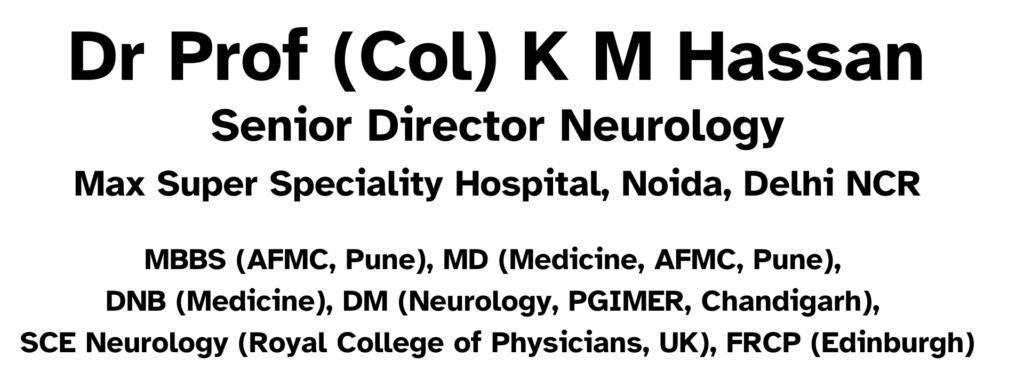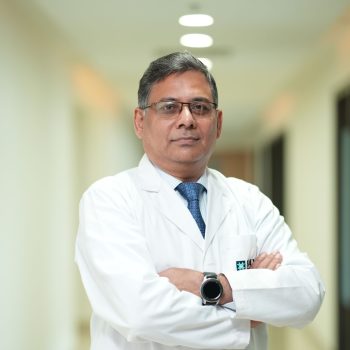Stroke is Brain Attack: Treatment is Race Against Time

When stroke strikes – a real story!
It was a festive occasion and a family get together for Mrs and Mr Sharma (name changed) as their daughter was getting married a week away. Busy with wedding preparations Mrs Sharma had barely managed to find some time for dinner when soon after she was struck by inability to speak and weakness of left side of body. It was a bolt from the blue for the family. While Mrs Sharma was emotionally upset and lay paralysed in bed, Mr Sharma kept his composure and mustered courage to react promptly in the midst of crisis and rushed her to the Emergency Services of Jaypee Hospital, Noida at 11 in the night. No sooner that the patient arrived, the stroke team at the hospital had swung into action. After a quick clinical assessment by Dr K M Hassan, Associate Director in Neurology at Jaypee Hospital, Noida, she was rushed for imaging study of brain which showed a clot on the right side of brain. Hearing the news of brain attack the family was in panic but reposed trust in the attending doctors. Mrs Sharma was lucky as she was in the window period of stroke thrombolysis or clotbusting treatment. At around 45 minutes since arrival at the hospital, she received intravenous clotbusting treatment with recombinant tissue plasminogen activator (alteplase) as per standard protocol.
Mrs Sharma had only one concern and would repeatedly ask if she would be able to attend her daughter’s wedding few days away. By grace of Almighty, words of reassurance and timely treatment worked in her favour. To the delight of all and much to the satisfaction of Dr Hassan and his team, Mrs Sharma left the hospital walking and talking just 5 days after suffering a major stroke. And much to the joy of all, Mrs Sharma was there to grace the occasion of her daughter’s wedding just six days after she had been struck by a stroke. She was back to life as usual.
What is stroke?
Stroke or Brain Attack is a potentially life-threatening event in which part of brain is deprived of adequate oxygen and energy. Stroke may be Ischemic due to clotting in artery of brain that results in brain damage, or it may be haemorrhagic due to tear in wall of artery that results in bleeding in brain. Nearly 80 percent of all strokes are ischemic.
What is the burden of stroke?
Stroke is a major public health problem. According to World Health Organisation, one in six persons worldwide will have stroke in their lifetime, every two seconds someone in the world suffers from stroke, and every six seconds someone, somewhere will die from stroke. Stroke is the second leading cause of death above 60 years and commonest cause of disability with nearly 70% of survivors remaining vocationally impaired. As the population in a country ages, the burden of dealing with stroke will increase in terms of caring for an ever increasing number of new stroke patients and stroke survivors.
What are the risk factors of stroke?
Common risk factors for stroke are hypertension, diabetes, smoking, high cholesterol, physical inactivity and obesity. As lead author of a research work published in the journal Annals of Indian Academy of Neurology in 2013, I found smoking and alcohol as important causes of stroke in men younger than 50 years.
How to recognize stroke?
Stroke is a medical emergency. Time is brain.
Box 1: Warning symptoms of stroke
- Sudden weakness or numbness of face, arm or leg on one side of body
- Sudden loss of vision – particularly in one eye
- Sudden loss of speech or trouble talking or understanding speech
- Sudden severe headaches
- Sudden confusion
- Sudden dizziness, unsteadiness or falls
Box 2: THINK FAST: Screening tools such as BE FAST quickly help recognise stroke
| B = | Balance difficulty |
| E = | Eyesight change |
| F = | Facial drooping |
| A = | Arm weakness |
| S = | Speech slurring |
| T = | Time since onset |
What should be done when stroke occurs?
Treatment is race against time. Get to hospital immediately. Window of opportunity for salvaging dying brain tissue is first 4.5 hours since onset of stroke. Hence, it is important to ACT FAST.
How is stroke treated?
Patients of acute stroke on arrival at Emergency Department are attended by a stroke team that ensures priority in carrying out brain imaging and clotbusting treatment in first 4.5 hours in eligible patients. This treatment may carry small risk of brain haemorrhage which is outweighed by its benefits. Personal experience with timely clotbusting treatment has been very gratifying.
Why is clotbusting treatment underutilized?
Clotbusting treatment of stroke is underutilized due lack of public awareness of warning symptoms and delay in transportation. In a collaborative study in 2012 from a tertiary care hospital in Kolkata (unpublished data), I found that less than 2% of strokes reported to the hospital in first 4.5 hours.
What is mechanical thrombectomy?
For eligible patients with large vessel blockage in brain, mechanical thrombectomy or clot removal can be life and limb saving if done in first 6 hours of stroke onset. Mechanical thrombectomy involves removal of brain clot by using catheter and guide wire, and in select cases can be done even upto 24 hours since onset of stroke.

What are the lessons from Mrs Sharma’s real life story?
Mrs Sharma is among one of few lucky patients of stroke who make such remarkable recovery. At the place of stroke occurrence, quickly identifying the warning symptoms of stroke and rushing to hospital equipped with facilities to manage stroke, and at the hospital end, fast track assessment and evaluation in hospital emergency department followed by clotbusting treatment in the window period of 4.5 hours since onset of stroke, resulted in complete recovery from stroke. So when there is stroke, “Think Fast and BE FAST”.
Quick recognition of stroke at community level and fast tracking the evacuation and management at hospital level goes a long way in recovery from acute stroke.
Note: The information provided is a general medical advisory and does not necessarily apply to everyone. This information is not intended to provide medical advice. Please consult a doctor or contact a health care provider if you have a medical problem. If you have a medical emergency, call your doctor or emergency number immediately.

